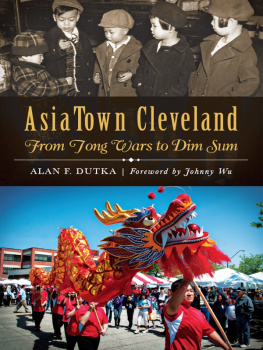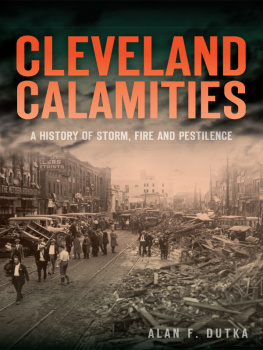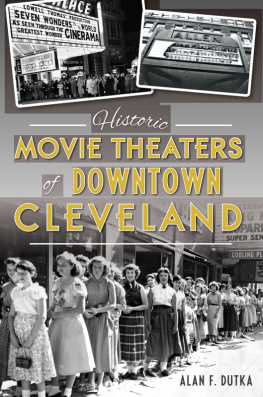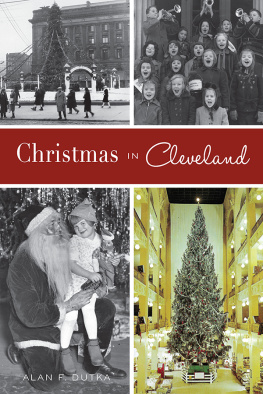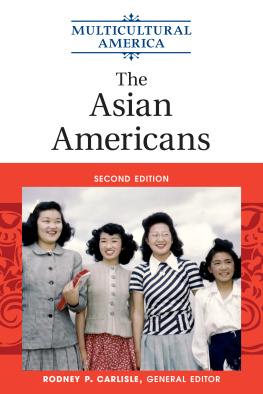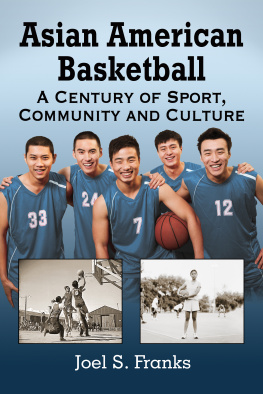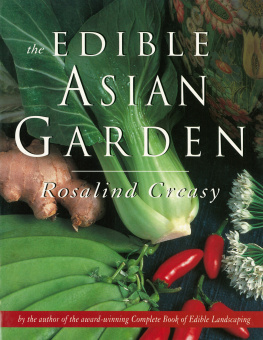

Published by The History Press
Charleston, SC 29403
www.historypress.net
Copyright 2014 by Alan F. Dutka
All rights reserved
First published 2014
e-book edition 2014
ISBN 978.1.62585.086.7
Library of Congress Control Number: 2014952358
print edition ISBN 978.1.62619.552.3
Notice: The information in this book is true and complete to the best of our knowledge. It is offered without guarantee on the part of the author or The History Press. The author and The History Press disclaim all liability in connection with the use of this book.
All rights reserved. No part of this book may be reproduced or transmitted in any form whatsoever without prior written permission from the publisher except in the case of brief quotations embodied in critical articles and reviews.
Contents
Foreword
As an active member of Clevelands Asian community, I was intrigued when Alan Dutka presented his idea to me of writing a book about Clevelands AsiaTown neighborhood. I am the co-founder of the annual Cleveland Asian Festival, currently the vice-president of organizations and community relations for the OCA Cleveland Chapter (formerly known as the Organization of Chinese Americans of Greater Cleveland), the producer and co-host of an hour-long radio program promoting AsiaTown and its events and a board member of the St. Clair Superior Development Corporation, where AsiaTown is located. I am also an award-winning producer, director and editor for videos and events branding and marketing, and my company is located in AsiaTown as well.
Alans book covers a lot of ground, from the first Chinese arriving in Cleveland in the 1870s to the current vibrant AsiaTown neighborhood. As his story progresses, he delves into how Asian culture and beliefs helped shape Clevelands AsiaTown. The book is well researched, and Alan is a good storyteller. Even though I have a grasp of Asian history in Cleveland, I found many really fascinating stories and anecdotes that I had never heard before. I would recommend this book to anyone interested in Cleveland history, Asian history or how the current AsiaTown neighborhood was shaped.
Johnny Wu
Preface
Before reaching adulthood, I had no real appreciation for Chinese culture. As a ten-year-old, I didnt relish the egg foo young my mother would bring home from a Chinese restaurant located in the basement of the Hippodrome Theater. Growing up, I never realized a Chinatown even existed in Cleveland, believing these exotic places would be found only in New York, San Francisco or on sets used to film old Charlie Chan movies shown on late-night television in the preJack Paar era.
Although eventually discovering the intriguing variety of foods offered in suburban Chinese restaurants, I never investigated Clevelands Chinatown until 2006. Since I lived in downtown Cleveland and had just purchased a new camera, I amused myself by locating and photographing a group of fiberglass canine sculptures placed around the neighborhood to celebrate the year of the dog. Neighborhood promoters thought the colorful dogs might call attention to the region; in my case, their idea proved to be correct.
Not knowing what to expect in an unfamiliar neighborhood, I parked my car as close as possible to each of the twenty-five or so sculpture sites. The next year, I repeated the process, this time photographing pigs. As the years passed, statuettes of rats, oxen, tigers, rabbits, dragons and snakes graced the streets of AsiaTown, the rebranded name for the old Chinatown area. Continuing to take photographs, I realized I didnt have to drive to each site. The neighborhood, not only very walkable, is also distinctive, interesting and even friendly. These fiberglass-inspired expeditions aroused my curiosity about the history of the neighborhood and its residents, shops and restaurants. This book represents my attempt to recount this history.
In order to not burden readers with street name changes occurring early in the twentieth century, all streets are referenced using their current names. Thus, Seneca Street, the location of the first concentrated Chinese settlement, is referred to as West Third Street, its current name. Also, references to proper Chinese names can be confusing since, for example, Wah Louie and Louie Wah refer to the same person, the difference explained by the specific time period and Mr. Wahs interest in adopting American customs. To the extent possible, I have employed the naming convention that each individual seemed to choose.
Acknowledgements
The following individuals provided significant contributions to this book:
CLEVELAND PUBLIC LIBRARY
Beverly Austin (history)
Margaret Baughman (photographs)
Nicholas Durda (photographs)
Thomas Edwards (history)
Patrice Hamiter (photographs)
Sabrina Rosario (history)
CLEVELAND STATE UNIVERSITY
William C. Barrow (Special Collections)
Lynn M. Duchez Bycko (Special Collections)
BUSINESSES/ORGANIZATIONS
James Amendola (St. Clair Superior Development Corporation)
Jaewon Chang (Miega Korean Barbeque)
Jung Chang (Miega Korean Barbeque)
Gary Chen (Park To Shop)
Michael Fleming (St. Clair Superior Development Corporation)
Steve Hom (Asia Plaza)
Cory Riordan (St. Clair Superior Development Corporation)
Siyan Wei (Siyan Dress)
Lisa Wong (Organization of Chinese Americans of Greater Cleveland)
Johnny Wu (Media Design Imaging)
Connie Zhang (Sisters Gift Shop)
Danny Zhang (Flower City Gift Shop)
INDIVIDUALS
Diane Dutka
Priscilla Dutka
Peter Haluszka
David Horan
Yin Tang
THE HISTORY PRESS
Greg Dumais
Jaime Muehl
Emily Kirby
Gracie Aghapour
Bob Barnett
Katie Parry
Introduction
As the nineteenth century ended, newspapers described Clevelands diminutive Chinese community as peculiar, strange, curious, odd and even queer, while referring to the Chinese themselves as almond-eyed celestials. The political incorrectness didnt foster harmonious relationships between the small number of Asians and the remainder of the citys population. Rumors conveying the existence of mysterious trapdoors, hidden passageways and decadent opium dens and gambling houses fascinated the mainstream population, which never became part of the closed, secretive and seemingly exotic Chinese society.
A handful of Chinese residents shaped a tentative community on West Third Street, followed by a more substantial neighborhood on Ontario Street, only to see the latter condemned and demolished. Rockwell Avenue, Chinatowns next locality, survived for sixty years before competition, crime and waning interest ended its reign.
In the twenty-first century, the citys growing AsiaTown community is viewed by many Clevelanders as hip and chic rather than as peculiar or strange. Coexisting with many nationalities in a racially diverse area, the neighborhood draws people from many parts of the city and surrounding suburbs. Chinese, Korean and Vietnamese restaurants cater to an expanding Asian population, while diners from vastly different ethnic backgrounds have transformed these eateries into destination locations. Newly built malls house Asian restaurants, grocery stores and specialty shops. The once-secretive Asian community enthusiastically welcomes daily visitors, promotes its New Year celebrations and stages an annual two-day spring festival attracting more than forty thousand Greater Clevelanders. Meanwhile, the old Rockwell Avenue Chinatown is exhibiting noteworthy signs of revival.
Next page
